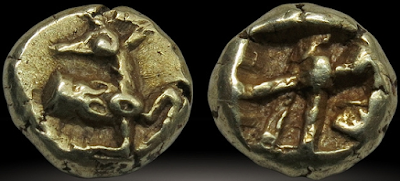 Ionia, Circa 650-600 BC. Hekte (one-sixth stater) Ionia, Circa 650-600 BC. Hekte (one-sixth stater) | Little is known about this electrum (natural alloy of gold and silver) coin. It was minted in Ionia, somewhere in central Western Anatolia on the shores of the Aegean, but the precise city-state that produced it is unknown. It could have been minted in Miletus, a city often referred to as the origin of the modern world. This type likely represents the first true coins which circulated in everyday use. This type are small 1/24th staters which represented about a day’s pay. Larger denominations are rare. Even fewer trites (one-third stater) are known, and only three full-size staters have ever been found. |
| During the excavation of the Temple of Artemis at Ephesus (present day Turkey near the Black Sea), a group of coins was found which are thought to be its 'foundation deposit', a custom that supposedly prevented the building from falling into ruin. The largest type in the group, a stater, had an inscription stating, 'I am the badge of Phanes'. It's meaning has been lost to antiquity. Coins revolutionized commerce, offering an accessible, neutral medium through which transactions could be processed quickly and fairly. |  |

No comments:
Post a Comment